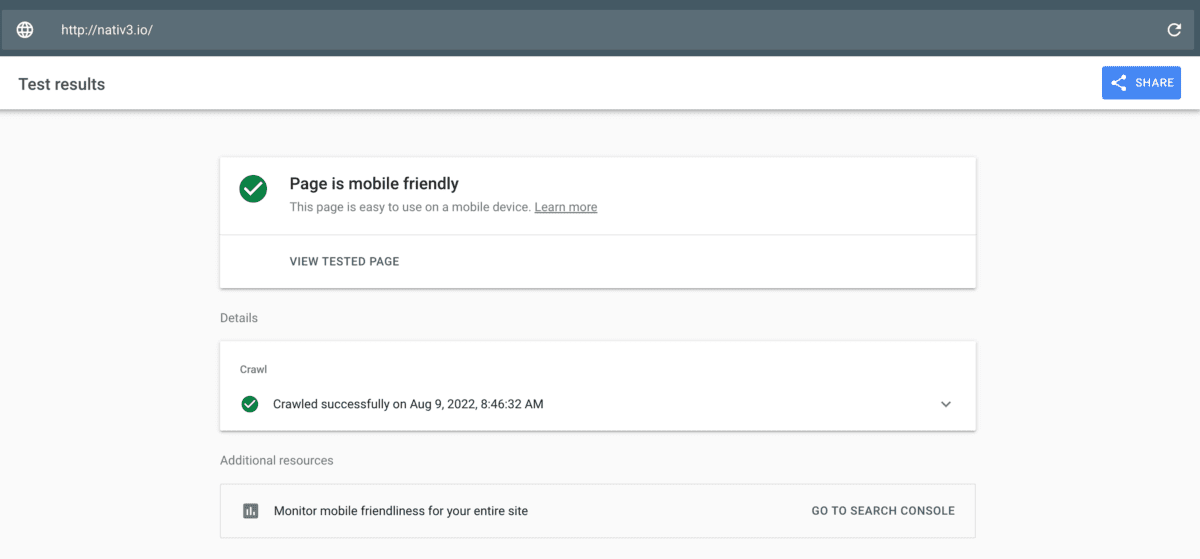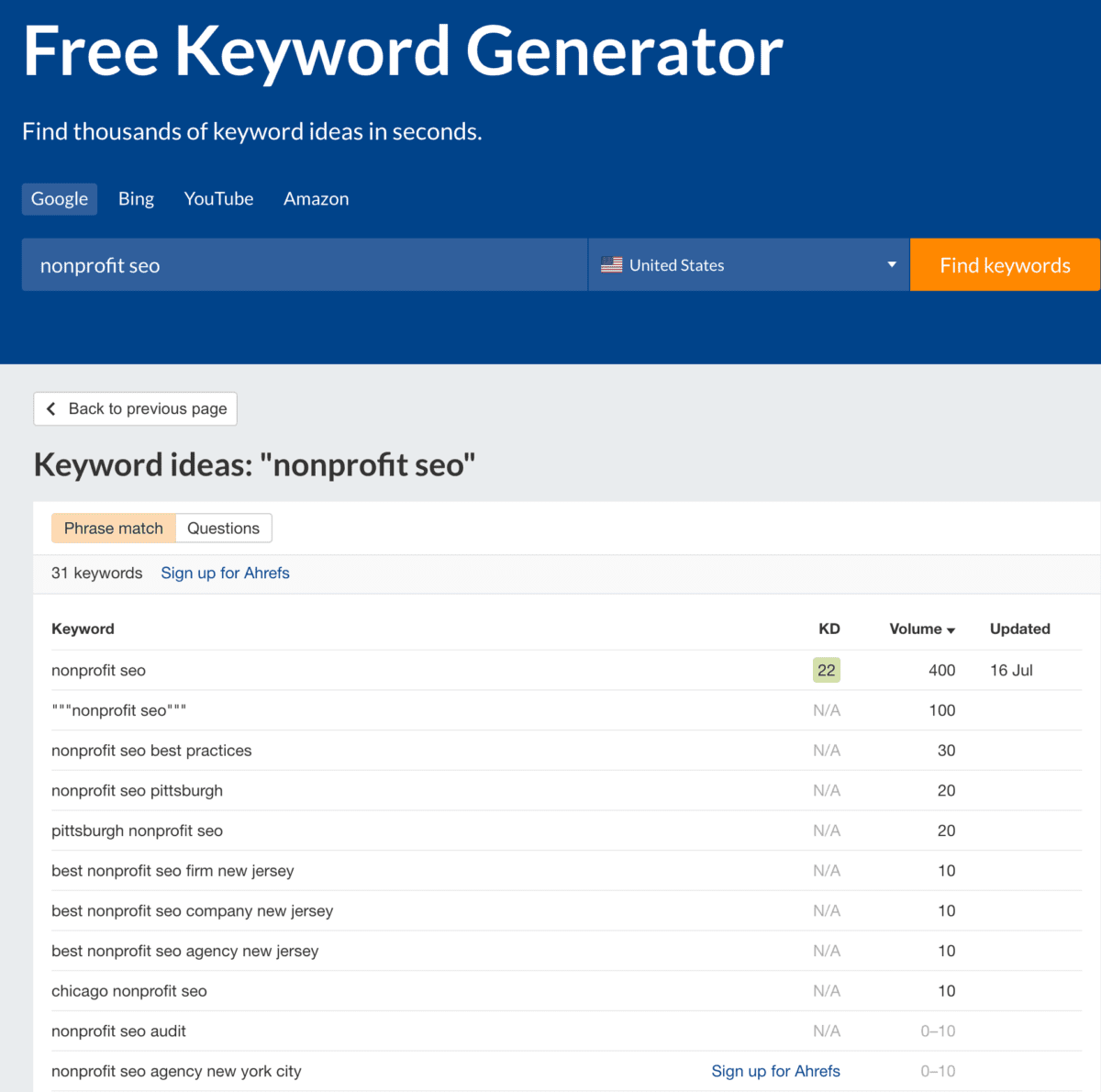The Quick and Dirty Guide to Non-Profit SEO

Let’s face it: nonprofit SEO is complicated.
Unless you’re well-trained in the topic of search engine optimization, it’s also a massive time suck, a resource that people busily running a charitable organization typically don’t have a lot of.
That said, we know how crucial it is for nonprofits to improve their search rankings. We have total confidence in your abilities to DIY your nonprofit SEO, at least until you have the budget to hire someone else to handle it for you. To help you out, we’ve put together a quick start guide that briefly outlines key considerations, helpful resources, and actionable tips that even complete novices can implement.
What We’ll Cover:
- What is SEO (in 100 words or less)?
- 10 Nonprofit SEO Rules
- Conducting Intent-Based Keyword Research
- The 3 Key Types of SEO + 5 Get-Started Steps
What is Nonprofit SEO (in 100 Words or Less)?
Nonprofit SEO, or search engine optimization, uses targeted keywords to rank higher than competitors on search engine results pages.
Corporations, small businesses, and nonprofit organizations should create digital content with SEO in mind to attract donors, volunteers, and clients to your website.
10 Rules for Implementing Nonprofit SEO
Now that you know what SEO is, it might be tempting ht in. Kindly don’t.
The scope of SEO is absolutely overwhelmingly massive, encompassing three separate categories of varying technicality and difficulty. Attempting to bite off more than you can chew is a recipe for disaster and one that could result in you further postponing your implementation of these crucial practices.
Instead, let’s start with a few rules of best practice that will help you create a sustainable, scaled strategy focused on measurable results while simultaneously averting the parts of nonprofit SEO that require an expert touch.
1. Analyze before you implement.
Before you roll out any changes, you need to see where you stand. That requires keyword research and a site audit. We’ll talk more about those in a minute.
2. Start where you are.
Once you have the data from your site audit and keyword research, you can pinpoint site pages with the potential for simple cleanup and optimization. Typically, that looks like adding in heading meta tags, rewriting content with your keywords in mind, and breaking large swaths of text into smaller sections.
3. Focus on authentic content.
When you’re ready to start rolling on SEO-optimized content, it’s tempting to partake in an old-fashioned, ineffective practice of keyword stuffing. Not only does it hurt your chances of ranking higher in search engines, but it also tells your visitors that you’re more interested in the rankings than you are in providing high-value information.
4. Practicality first, creativity later.
Another issue we frequently see in DIY SEO newbies is a tendency to think about big, creative pursuits like overhauling an entire domain or mass-producing blog content rather than establishing a baseline habit of thinking about their digital content through an SEO-informed lens. Again, this is not a good idea. It’s almost inevitably going to lead to burnout, which means your site still isn’t up to par, so your rankings continue to suffer.
5. Take a multimedia approach.
Video content is HUGE in terms of communicating a nonprofit narrative. It’s also highly engaging and significantly easier to consume than blog content. If you insist on branching out from the easy stuff on your own, creating videos to add to your site and share on social media is the way to go.
6. Measure your progress.
SEO is perpetual. Other nonprofits with large marketing budgets are investing in agency services that continually work to produce optimized content, improve their website, and attract visitors via digital marketing. If you’re going to DIY, you also have to take on the responsibility of ongoing accountability and result monitoring, which includes adding new keywords to your list and reauditing your site.
7. Roll with the punches.
Agencies also serve as a filter for trends and technical changes in terms of content optimization, which means that you’ll need to do the same in order to stay relevant. Set aside time once a week to review trusted SEO publications, then consider how you can capitalize on your knowledge to get better results.
8. Don’t forget mobile.
Google favors mobile-responsive sites over those that aren’t, which makes sense given that mobile traffic accounts for 59% of all web traffic as of June 2022. Site visitors should trust that your website will scale to their device’s screen size and offer a fully integrated user experience regardless of the display ratio. You can check whether your site is responsive with the Google Searh Console Mobile-Friendly Test.


9. Do what you can, when you can.
If you find yourself neglecting best SEO practices or feeling overwhelmed by the whole practice, slow down. It’s better to do it little by little than not at all. It’s also okay to take a break when you need, so long as you hold yourself accountable for getting back in the habit when you’re ready.
10. Wait (and then wait some more).
SEO and search ranking improvements don’t work overnight or even over the course of a week. In fact, it could be months before you start to see significant results.
It’s a process that requires patience and determination, well worth the end result of seeing increased donations and interest in your nonprofit.
Conducting Keyword Research
Keywords— or the unique combinations of words that users type into a search engine— are the lynchpin of SEO. By thoughtfully selecting and optimizing for search terms that your target audience is most likely to use when looking for a nonprofit like yours, you are giving yourself the power to direct traffic to your website.
For now, you’ll want to focus on the searcher’s intention to decide on your keywords:
Commercial Intent
The searcher is researching specific brands, organizations, products, or services.
- nonprofit database site
- susan g koman vs national breast cancer foundation
- minneapolis animal shelter review

Informational Intent
The searcher is looking for answers to their questions.
- how does tom’s shoes give back?
- what nonprofits are most in need?
- why should i make charity donations?

Navigational Intent
The searcher is navigating to a specific website.
- world wildlife foundation
- ces foodshelf
- washburn center for children

Transactional Intent
The searcher is ready to take action by signing up to volunteer, pledging a donation, or making a purchase.
- donate to doctors without borders
- meal volunteer ronald mcdonald house
- good in the hood recurring donation

Try to create a spread of blog posts and website content that meets the needs of all four types of search intent. Focusing too heavily on one means that you’re missing out on 75% of search traffic looking for organizations like yours.
Keyword Research Tools
Free keyword research tools abound, though some have a heftier suite of features and more reliable results than others.
- Google Trends lets you search the popularity of any keyword you can think of and presents search data visually. It does not provide recommendations for more keywords based on your industry or organizational focus.

- Google Keyword Planner provides resources for building keyword lists based on your keyword ideas or your website’s existing content.

- Ahrefs offers a free, lite version of their premium SEO tool. Just type in a keyword or keyphrase to populate a list of 10 relevant ideas.

- Keyword Surfer is a free Chrome extension that generates keyword lists directly within the SERP.

The 3 Key Types of SEO + 5 Get-Started Steps
Now, it’s time for the exciting part: Steps you can take today to improve your internal, external, and technical SEO.
These tips are relatively basic, but will form the foundation of your ongoing nonprofit SEO strategy.
Internal SEO
Also called “on-site” SEO, this consists of optimizing your own website’s content, formatting, and metadata with keyword data in mind.
- Install the YOAST WordPress extension and review their instruction guide. YOAST allows you to access an on-page console where you can set keywords and generate metadata, which then returns visual confirmation of site optimization progress.
- Assign a relevant keyword to each public page on your site.
- Edit your SEO titles to include the assigned keyword.
- Craft a page meta description that includes the assigned keyword.
- Break page content into sections with cascading HTML headings.
External SEO
“Offpage” SEO consists of social media marketing, guest blogging, and backlinks, all of which help increase your website authority and encourage Google to rank your pages higher.
- Read through The Ultimate Guide to Nonprofit Marketing Strategy in 2022 and 26 Tips for Nonprofit Marketing in 2022.
- Draft a basic strategic plan for the social media platforms on which you plan to build a presence.
- Create business accounts on the platforms you chose:
- Draft 1 week of social media posts on a collaborative platform, such as Airtable or Google Sheets.
- Find one local nonprofit you’d like to partner with, then draft a guest post or resource you’d like to share with them to start building a backlink profile.
Technical SEO
Technical SEO involves changes to your server that aids Google in effectively crawling and indexing your site. We do not recommend making deep, code-based changes to your site. It’s completely fine to focus on internal and external SEO, then let an agency handle server-side changes.
There are a few checks you can perform, though, to help you assess the scope of changes you need to make.
- Ensure your site carries an SSL certificate.
- Delete or rewrite any duplicate content.
- Check your site speed.
- If you haven’t yet, use the tool mentioned above to evaluate mobile responsiveness.
- Register your site through Google Search Console and consider taking their free course to take advantage of the features.
What’s Next?
That’s it! You’re well on your way to improving your nonprofit SEO!
As you get more comfortable with the process, be sure to check back on our blog for more resources. We’re always adding new guides, resources, and information to help organizations of all sizes tame their digital landscape.